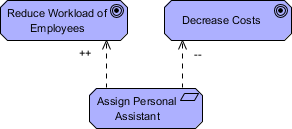The influence relationship models that an element affects the implementation or achievement of some motivation element. The example below illustrates the use of the influence relationship to model the different effects of the same motivation element, Assign Personal Assistant. This has a strongly positive influence on Reduce Workload Of Employees, but a strongly negative influence on Decrease Costs.

The influence relationship is used to describe that some architectural element influences achievement or implementation of a motivation element, such as a goal or a principle. In general, a motivation element is realized to a certain degree.
For example, consistently satisfying the principle ‘serve customers wherever they are’ will help to make the goal ‘increase market share’ come true. In other words, the principle contributes to the goal. In turn, to implement the principle ‘serve customers wherever they are’, it may be useful to impose a requirement of ‘24×7 web availability’ on some customer-facing application component. This can be modeled as a requirement that has an influence on that principle, and as an application component that in turn influences the requirement.
Why Influence Relationship
Consistently modeling these dependencies with an influence relationship yields a traceable motivational path that explains why (in this example) a certain application component contributes to the corporate goal to ‘increase market share’. This kind of traceability supports measuring the results of Enterprise Architecture, and provides valuable information to, for example, change impact assessments.
Additional to this ‘vertical’ use of contribution, from core elements upwards to requirements and goals, the relationship can also be used to model ‘horizontal’ contributions between motivation elements. The influence relationship in that case describes that some motivation element may influence (the achievement or implementation of) another motivation element. In general, a motivation element is achieved to a certain degree. An influence by some other element may affect this degree, depending on the degree in which this other element is satisfied itself.
For example, the degree in which the goal to increase customer satisfaction is realized may be represented by the percentage of satisfied customers that participate in a market interview. This percentage may be influenced by the goal to improve the reputation of the company; i.e., a higher degree of improvement results in a higher increase in customer satisfaction. On the other hand, the goal to lay off employees may influence the company reputation negatively; i.e., more lay-offs could result in a lower increase (or even decrease) in the company reputation. And thus (indirectly), the goal to increase customer satisfaction may also be influenced negatively.
Realization vs Influence Relationship
The realization relationship should be used to represent relationships that are critical to the existence or realization of the target, while the influence relationship should be used to represent relationships that are not critical to the target object’s existence or realization.
For example, a business actor representing a construction crew might realize the goal of constructing a building, and a requirement to add additional skilled construction workers to an already adequate crew might influence the goal of constructing the building, but also realize an additional goal of opening the building by a particular date. Moreover, an influence relationship can be used to model either:
- The fact that an element positively contributes to the achievement or implementation of some motivation element, or
- The fact that an element negatively influences – i.e., prevents or counteracts – such achievement
Strength of Influence
Attributes can be used to indicate the sign and/or strength of the influence. The choice of possible attribute values is left to the modeler; e.g., {++, +, 0, -, –} or [0..10]. By default, the influence relationship models a contribution with unspecified sign and strength.
Related Articles: